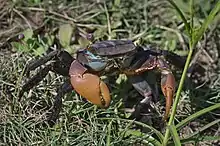| Afruca tangeri | |
|---|---|
_male.jpg.webp) | |
| male, Gambia | |
| Scientific classification | |
| Domain: | Eukaryota |
| Kingdom: | Animalia |
| Phylum: | Arthropoda |
| Class: | Malacostraca |
| Order: | Decapoda |
| Suborder: | Pleocyemata |
| Infraorder: | Brachyura |
| Family: | Ocypodidae |
| Genus: | Afruca |
| Species: | A. tangeri |
| Binomial name | |
| Afruca tangeri (Eydoux, 1835) | |
| Synonyms [1] | |
| |

Afruca tangeri is a species of fiddler crab that lives along the Atlantic coasts of western Africa and southwestern Europe.[2]
Description
Afruca tangeri is one of the largest species of fiddler crab, with a carapace up to 50 millimetres (2.0 in) wide,[3] and up to 25 mm (1.0 in) long.[4] The males have one claw much larger than the other, which they use for communication.[5] Body colouration is fairly dull for a fiddler crab, but individuals are a variety of colours from dull shades of brown, to bright orange, red or purple.
Distribution
The range of Afruca tangeri extends from southern Portugal southwards to Angola;.[4] It is the only fiddler crab species on the Eastern Atlantic coast and the most abundant crab in The Gambia.[5]
Taxonomy
Afruca tangeri was first described by Joseph Fortuné Théodore Eydoux in 1835 as Gelasimus tangeri, but for many years it was part of the genus Uca, which then contained all the fiddler crabs worldwide. Fiddler crabs, and all crabs in the family Ocipodidae have recently undergone a major taxonomic revision using new molecular phylogenetic evidence,[1] which divided the fiddler crabs into 13 new genera. Therefore, the West African fiddler crab now forms the only species in the new genus, Afruca. The specific epithet tangeri refers to the Gulf of Tangier, Morocco, the species' type locality.[4] The common name preferred by the Food and Agriculture Organization is West African fiddler crab (French: gélasime africain; Portuguese: boca-cava-terra).[6]
See also
References
- 1 2 Shih, Hsi Te; Ng, Peter K.L.; Davie, Peter J.F.; Schubart, Christoph D.; Türkay, Michael; Naderloo, Reza; Jones, Diana (2016). "Systematics of the family Ocypodidae Rafinesque, 1815 (Crustacea: Brachyura), Based on phylogenetic relationships, With a reorganization of subfamily rankings and a review of the taxonomic status of Uca Leach, 1814, Sensu lato and its subgenera" (PDF). Raffles Bulletin of Zoology. 64: 139–175.
- ↑ Rosenberg, Michael S. (2019). "A fresh look at the biodiversity lexicon for fiddler crabs (Decapoda: Brachyura: Ocypodidae). Part 1: Taxonomy". Journal of Crustacean Biology. 39 (6).
- ↑ Richard G. Hartnoll (1988). "Evolution, systematics, and geographical distribution". In Warren W. Burggren; Brian Robert McMahon (eds.). Biology of the Land Crabs. Cambridge University Press. pp. 6–54. ISBN 978-0-521-30690-4.
- 1 2 3 R. W. Ingle (1997). "True crabs (Brachyura)". Crayfishes, Lobsters, and Crabs of Europe: an Illustrated Guide to Common and Traded Species. Springer. pp. 115–176. ISBN 978-0-412-71060-5.
- 1 2 Craig Emms; Linda Barnett; Richard Human (2006). "Natural history". The Gambia (2nd ed.). Bradt Travel Guides. pp. 25–46. ISBN 978-1-84162-137-1.
- ↑ Domingo Lloris; Jaime Rucabado (1998). "Crustacés". Guide d'Identification des Ressources Marines Vivantes du Maroc. Guide FAO d'identification des espèces pour les besoins de la pêche (in French). Food and Agriculture Organization. pp. 165–192. ISBN 978-92-5-204162-7.